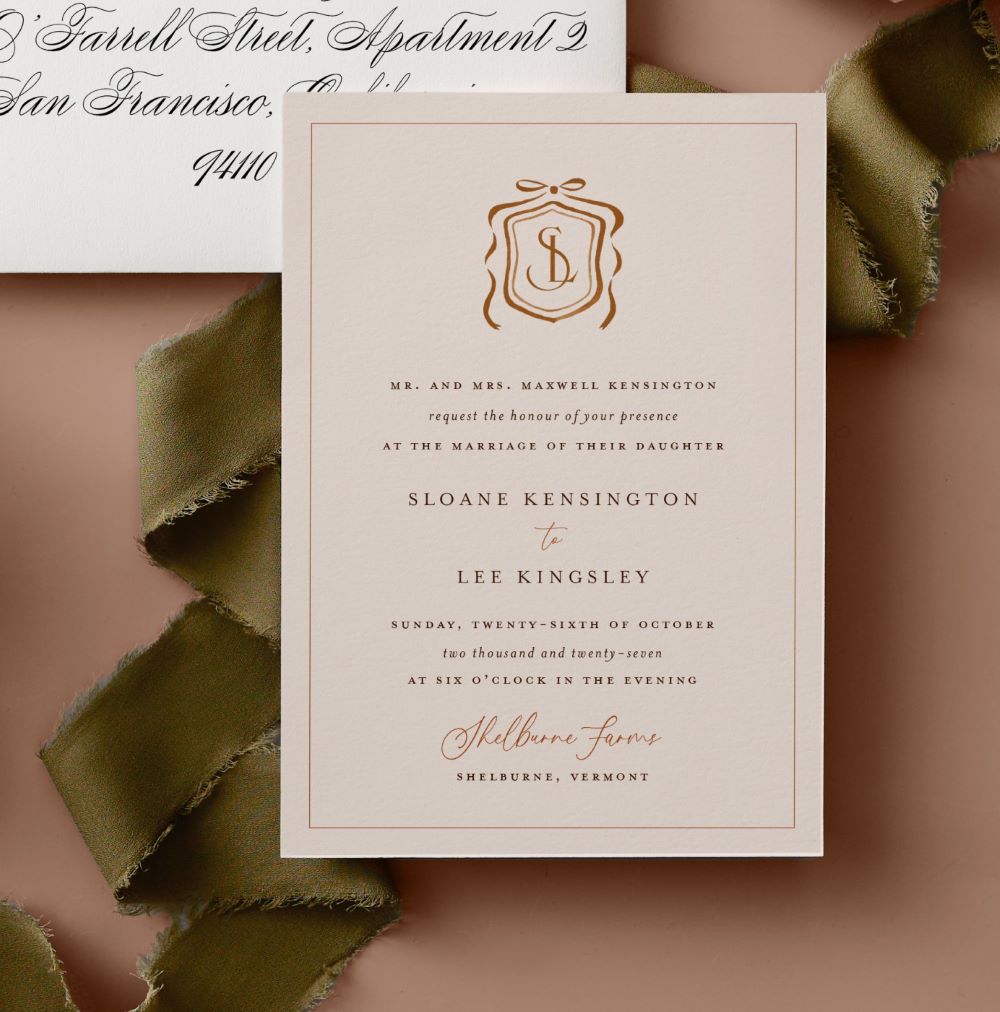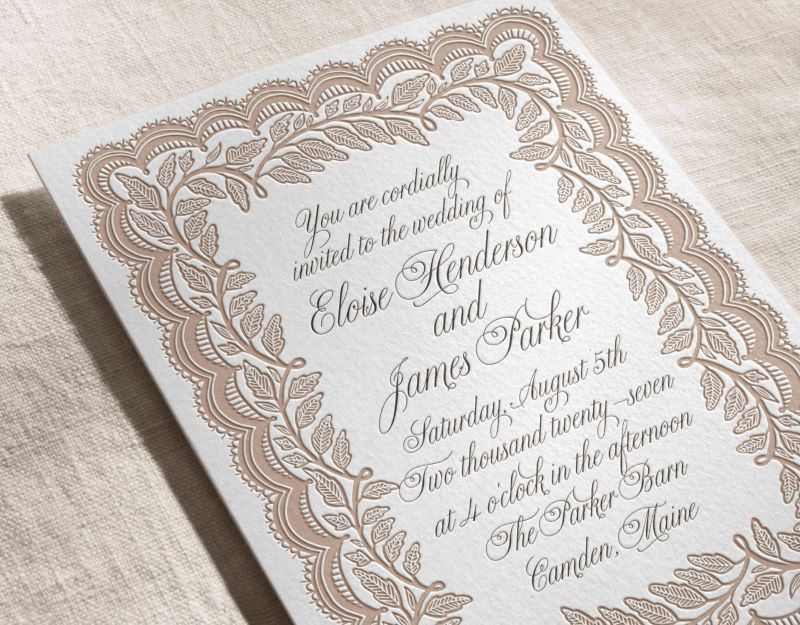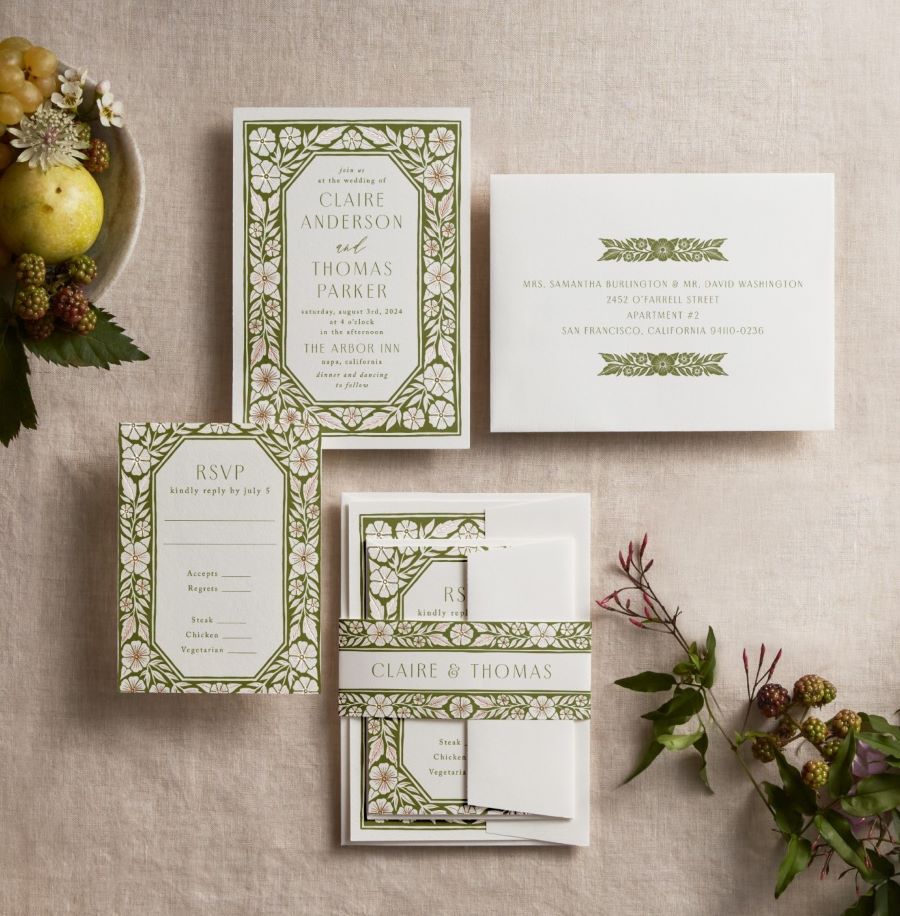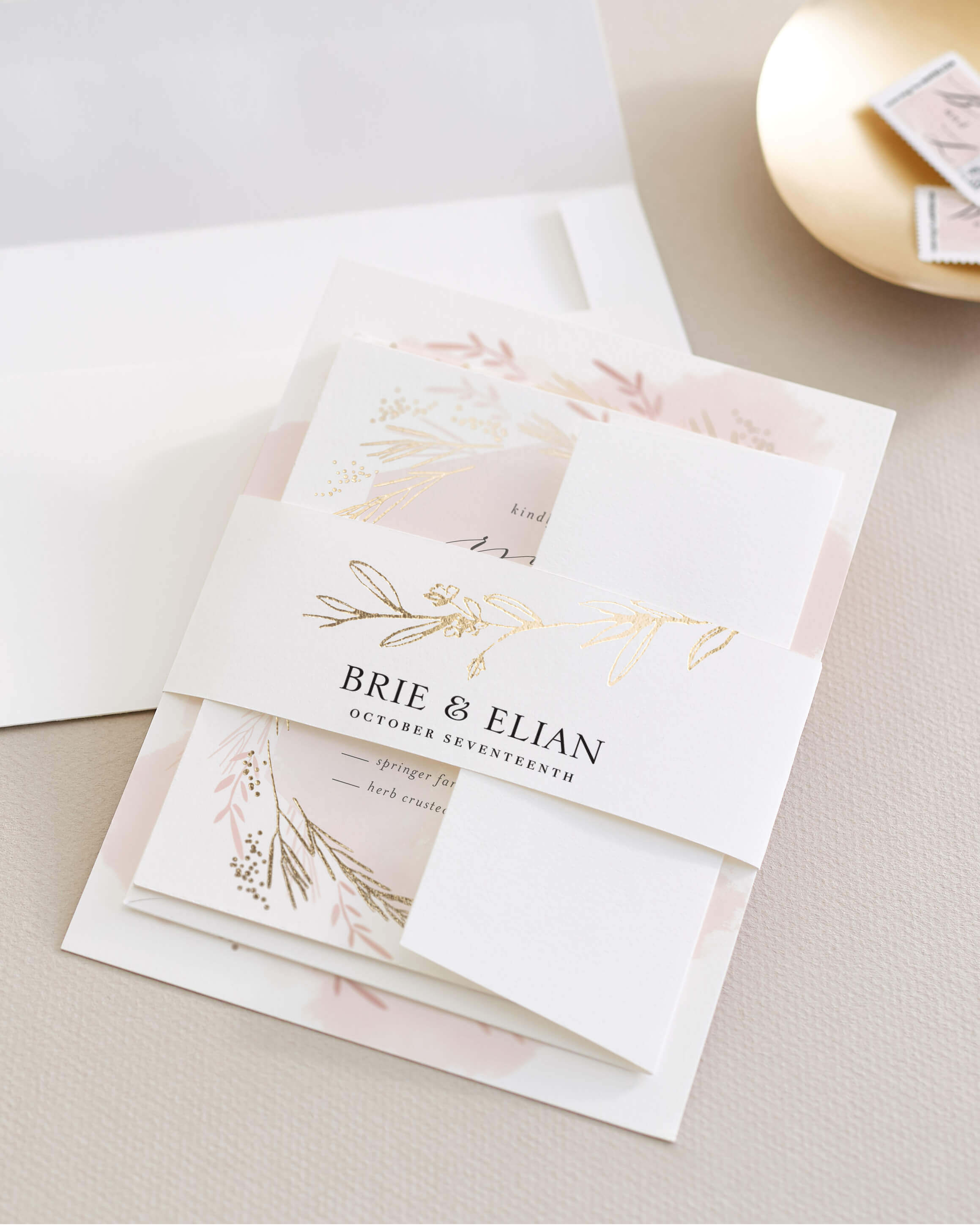So you’ve set a date, chosen a venue, and maybe even settled on a wedding invitation. (If not, our sample kit can help.) Cheers to you! Admittedly, crafting the wording for your wedding invitation can be a little tricky. But fear not: You don’t have to be a wordsmith or Miss Manners to figure it out. We’ve compiled everything you need to know about exactly what to write on each line—and how to handle some of the etiquette situations you’re likely to encounter.
What to include
1. Host Line
Wedding invitation wording starts with a host line. Traditionally the bride’s parents are hosting, and so their names come first. But no matter who’s paying for the wedding, listing the names of both sets of parents is acceptable (and gracious). If the couple and their parents are contributing, you can opt for something like, “Together with their parents” or “Together with their families.”
A common way to honor a deceased parent is alongside one of the couple’s names. Here’s an example: “Lauren Martinez, daughter of Marta Martinez,” or “Lauren Martinez, daughter of Robert Martinez and the late Marta Martinez.”
Host Line Wording Examples
One Set of Married Parents Hosting
Include the parents’ full names (with middle names for very formal weddings). If they have different last names, write “and” to join the two names.
- Mr. and Mrs. Christopher Timothy Williams (very formal; middle name is included)
- Mr. and Mrs. Christopher Williams (formal)
- Mr. and Mrs. Christopher and Sarah Williams (formal; includes both first names)
- Christopher and Sarah Williams (less formal)
One Set of Divorced Parents Hosting
Include the mother’s name first, followed by the father’s name. Do not use “and” to connect the two names; rather, each name should get their own separate line.
- Mrs. Rachel Arroyo
- Mr. Michael Nguyen
Both Sets of Parents Hosting
For different-sex couples, list the bride’s parents’ names at the top of the invite, then the groom’s parents’ names. For same-sex couples, list the names according to preference or in the order that looks best with the invitation design.
- Mr. and Mrs. Aaron Wong and Mr. and Mrs. Adam Hollis (formal)
- Aaron and Alisha Wong together with Adam and Beatrice Hollis (less formal)
Couple Is Hosting With Their Families
When the couple and both of their families are contributing to the cost of the wedding, many choose to add a line such as “Together with their families” as the host line.
- Together with their families
- Together with our families
- Together with their parents
Couple Is Hosting
If the couple is hosting the wedding themselves, you can skip the host line altogether or start the invitation wording with a warm and welcoming introduction, such as:
- With open hearts
- Together with full hearts
- With great joy
- With hearts full of love and joy
2. Request line
This is where you extend the invitation to attend your wedding, and you can use it to set the tone for your celebration. Here are a few more things to keep in mind:
- “The honor of your presence” is traditionally used to denote a religious service. Some couples opt to spell “honour” using the British spelling to evoke a more formal and traditional feel. (Note: If you’re using “honour” on the invitation, we recommend matching it with “favour,” as in “favour of your reply,” on the RSVP card.)
- “The pleasure of your company” (or variations on this) is used to denote a non-religious ceremony locale.
Request line wording examples
- request the honor of your presence
- request the pleasure of your company
- invite you to celebrate with them
- would love for you to join them
3. Action line
Here, you’re outlining what you are inviting people to share in (cue the confetti). There are many ways to word this depending on who’s hosting and how formal your wedding will be.
Action line wording examples
- at the marriage of their daughter (if the bride’s parents are hosting)
- at the marriage of their children (if both sets of parents are hosting)
- at the celebration of their union (if the couple is hosting)
- as they say “I do!”
- in celebration of their marriage
4. Couples’ Names
This one might seem easy—until you start thinking about the nitty-gritty details. Whose name goes first? Do you have to include last names? What about middle names? Though there really are no right or wrong answers—do whatever feels most comfortable to you both—here are a few suggestions:
- For different-sex couples, the bride’s name typically goes first, followed by the groom’s name. If the bride’s parents’ names are listed at the top, the bride’s name can just be her first and middle name (without last name). In that case, the groom’s name is either listed in full, or his first and middle names are listed followed by the line “Son of Mr. & Mrs. Stephen Wong.”
- For same-sex couples, you can list the names in alphabetical order by last name or based on what looks best with the design of the invitation.
- For a less formal feel, you may opt to list first names only.
5. Date & Time
Traditionally, the date and time should be spelled out in full. For example, if your ceremony is on September 15, 2024, at 4:30 p.m., the wording should read, “Saturday, the fifteenth of September, two thousand twenty-one, at half after four in the afternoon.” The day of the week and the month should be capitalized, and the year should be lowercase. There is no “and” when spelling out the year.
The time of day should be spelled out as “four o’clock” or “half after four o’clock.” Evening begins at five o’clock. From noon until four o’clock is considered afternoon.
Date & Time Wording Examples
- 4:00 p.m. can be spelled out as:
- four o’clock (traditional)
- four o’clock in the afternoon (also acceptable)
- 4:00 p.m. (informal)
- 4:00 p.m. in the afternoon (informal)
- 4:30 p.m. can be spelled out as:
- half after four o’clock (traditional)
- half past four o’clock (also acceptable)
- four-thirty in the afternoon (also acceptable)
- 4:30 p.m. (informal)
6. Location
- List the ceremony venue as follows: “Venue Name” on one line, “City, State” on the following line. For formal weddings, the state name is usually spelled out.
- The venue’s street address is traditionally not included unless the venue is a private residence.
- Zip codes are not usually included.
7. Reception line
If the reception will be at the same location as the ceremony, you can simply say, “Reception to follow” or “Dinner and dancing to follow.” If the reception is at a different location, you can list the venue on the following line or on a separate insert card, called a reception card. And if you’re not serving a full meal, this would be a great place to let guests know by saying something like, “Join us after the ceremony for cocktails, hors d'oeuvres, and dancing.”
Reception line wording examples
- Reception to follow
- Reception immediately following the ceremony
- Dinner and dancing to follow
- Cake, punch, and merriment to follow (if you’re not serving a full meal)
- Feasting and merriment to follow
- Dining, dancing, and happily ever after to follow
Other Considerations
Dress Code
This is optional, but it can be helpful for guests. One exception: If your wedding is black tie, you must include that on the invitation. If you don’t include wedding attire information on the invitation, guests will infer it based on the formality of the wedding invitation itself. For example, if the invitation is formal, guests will likely anticipate a formal affair. A simpler invite suggests wedding attire that leans more casual. The dress code line should be listed on a line following the reception location.
Dress Code Wording Examples
- Black-tie (tuxedos and floor-length gowns)
- Formal attire (suits and dresses)
- Cocktail attire (suits or dress shirts with ties and cocktail dresses)
- Beach-casual (long- or short-sleeve shirts with pants or shorts, sundresses, and sandals)
Wedding Website
Typically you don’t print your wedding website on the main invitation card; rather, you should list it on one of a reception card or an additional information card. It’s also a good idea to have your wedding website URL (or the QR code) on your wedding save the date card.
Complete Your Suite
Wondering what else to send with your wedding invitation? Read on for exactly what you'll need to include.
RSVP Cards
Good news! Wording the RSVP card (also called the reply card or response card) is a simpler task than the invitation. Here’s what you’ll need to include:
RSVP date: The first piece of information on the card is the reply-by date, which is typically three to four weeks before the wedding. This will give you enough time to get a final head count to the caterer (one week before) and to finalize your seating chart.
Remember to keep the wording consistent with the invitation. For example, “the favor of a reply” typically matches the invitation wording “the honor of your presence.” For less formal wedding invitation wording, such as “request the pleasure of your company,” the RSVP wording would typically be “Kindly reply by” or “Kindly respond by.”
Guest(s) names: Next is a line for guests to write their names, along with checkboxes for accepting or declining the invitation.
Most traditional weddings use the “M” line to indicate the place where guests will write in their names. The “M” itself is meant to designate the first letter of the formal salutation (Mr., Mrs., Miss or Ms.) that the guest would write along with their name(s). For less formal celebrations, we suggest the more straightforward “Name(s)” instead.
Additional information you can include: Meal choices, along with checkboxes or illustrated icons, and a song-request line such as, “We promise to dance if you play __________.”
Reception Cards
If the ceremony and reception are held at the same venue, include the line “Reception to follow” at the bottom of the invitation. However, if the reception is held at a different location, it should be treated as a separate event—include a separate reception card with the event details as part of the invitation suite.
Activity Card
Activity cards can be very helpful if your wedding has multiple events taking place during the wedding weekend. List all of the festivities open to guests in chronological order. Our complete guide on wedding detail cards will be helpful especially when you have a lot of information to share to your guests.
If you choose not to include the activity card in your invitation suite, make sure you list this information on your wedding website.
Information Card
An information card can be enclosed with your wedding invitation if you’d like to provide any additional wedding details to guests: directions, transportation information, lodging suggestions, etc. Make sure to check out our guide on how to assemble your wedding invitation suite, especially if multiple enclosure cards are involved.
Etiquette FAQs
Wondering what else to send with your wedding invitation? Read on for exactly what you'll need to include.
How do we let guests know we’re having an adults-only wedding?
Address your wedding invitations carefully. If you’re sending formal invitations with both an outer mailing envelope and an inner envelope, list only the names of the invited adult guests on both envelopes. If you’re sending outer envelopes only, list only the names of the invited adult guests. You can also write the names of each invited guest on the response card.
Do not put "adults only" on the wedding invitation. The more tactful, gentler way to get this message across is to encourage family members, wedding-party members, and friends to spread the word to other guests. Do include it on your wedding website.
Where do you include information such as your wedding website and wedding registry?
We don’t advise including your wedding website URL and wedding registry information on the main invitation card itself. An additional insert card in your invitation suite is the best place to put a QR code to your wedding website and/or your website URL (and password if you have one). If you’re already including an insert card with travel information or additional wedding details, you can print the URL on the bottom of that card.
Registry details are not typically included in the invitations. You can put that information on your wedding website. Oh, and if you’d like to ask for money instead of wedding gifts, you can create a cash fund or a gift card registry. Here are some ways to word your request:
- Your presence at our wedding is gift enough, but should you wish to buy us something, we'd greatly appreciate a contribution toward [insert cash fund here, and get specific about what it’s going toward: “buying a home,” “paying for our honeymoon,” etc.].
- We’re so lucky to have everything we need to start our life together. But if you wish to give a gift, we would be so grateful if you could help us make memories by contributing to our honeymoon fund.
- The best gift you could give us is your presence at our wedding. However, if you’re inclined to give us a gift, we would graciously accept a contribution to our [insert cash fund here].
Do you write guests' full names on the wedding invitations?
If following proper wedding invitation etiquette, yes. When you are addressing your invitation envelopes, you should spell their names out in full (title, first name, middle name (optional), and last name). Avoid using nicknames or initials. Be sure to use appropriate social titles as well, addressing married couples as "Mr. and Mrs." or "Mr. and Mr." For more on addressing your invitation envelopes, please see our in-depth guide to wedding envelopes and addressing.
When should our wedding invitations be sent out?
In order to send your wedding invitations in a timely fashion, aim to stick to the following timeline:
- 4–5 months before the wedding: Order wedding invitations
- 6–8 weeks before the wedding: Mail wedding invitations
If you’re hosting a destination wedding or are tying the knot over a holiday weekend, you’ll need to factor in more time so guests can make any necessary travel arrangements. Mail your wedding invitations three months ahead of time.
How much time should we give guests to RSVP for the wedding?
Set your RSVP deadline for three to four weeks before the wedding date. This timeframe will give you enough time to provide your caterer with a final head count, which is usually needed one week before the wedding. An accurate headcount will also allow you to finalize your wedding seating chart.
If some guests still have not responded by your RSVP deadline, give them a quick phone call to follow up.
Who should get a plus-one and who doesn’t?
This is a tricky question, so be sure to tread carefully as you and your partner determine what makes the most sense for your wedding guest dynamics. Here are our general wedding etiquette rules on plus-ones and whether or not you should give guests the opportunity to bring a date to the wedding:
- Married, engaged, and cohabitating guests should get a plus-one.
- Wedding-party members (bridesmaids, groomsmen, etc.) should get a plus-one.
- Guests who have been with their partner for a lengthy amount of time should get a plus-one. This, of course, is tricky. What constitutes a long enough period of time? While this varies for everyone, in general, our rule of thumb is that anyone who has been coupled up with their partner for so long that it would be awkward not to invite them should get a plus-one.
- For everyone else, make a blanket rule, such as “only immediate family members can bring a date” and stick to it.









